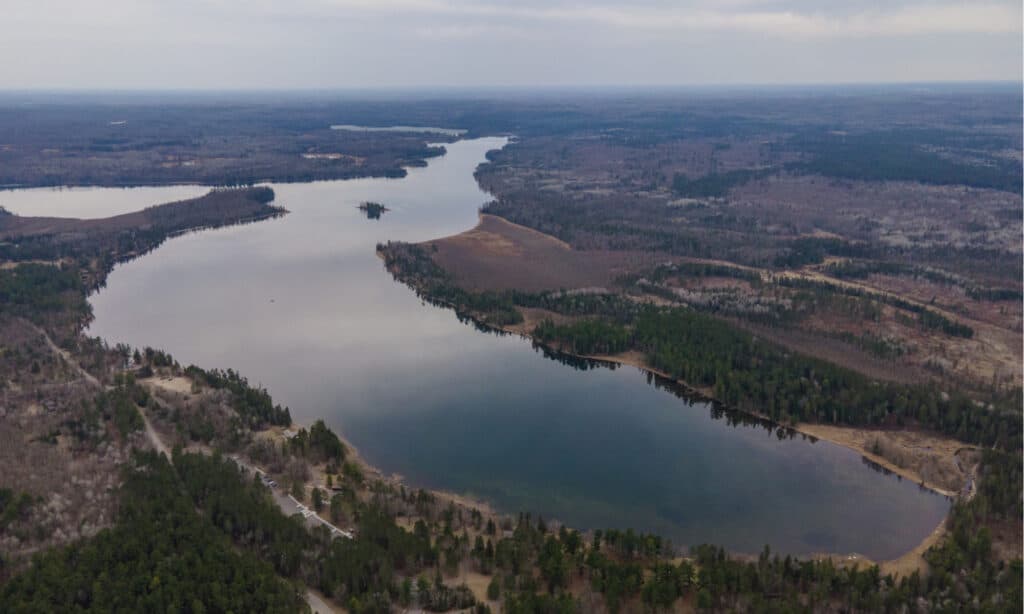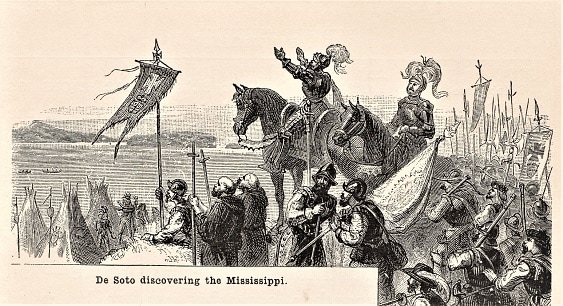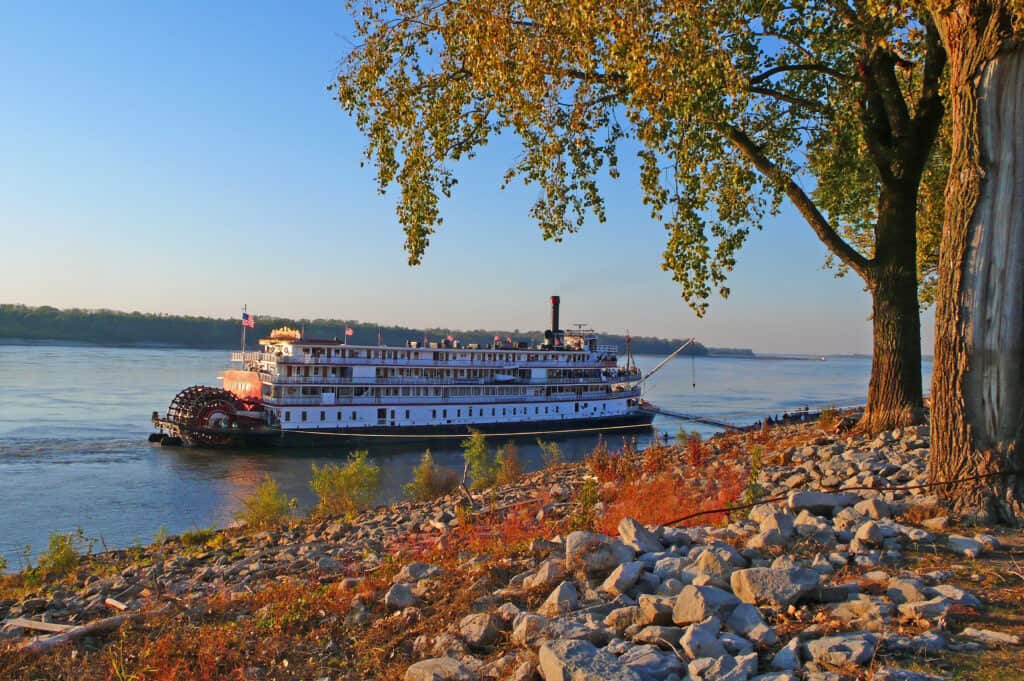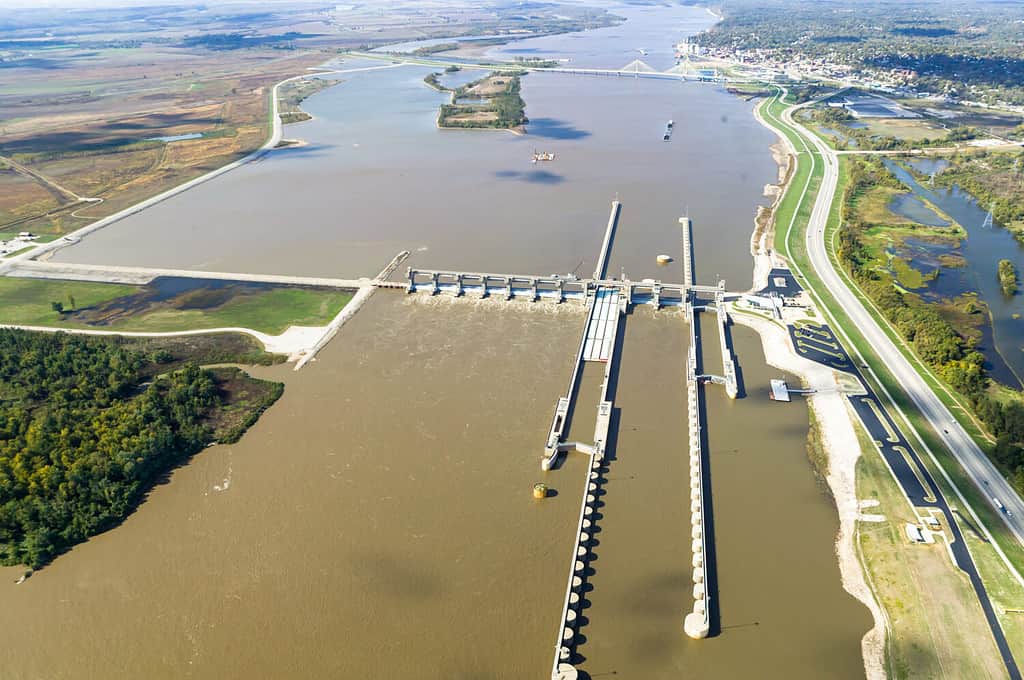A river of legends and livelihood, the mighty Mississippi River winds its way through America’s heartland and South. Flowing over 2,348 miles from its headwaters in Minnesota to the Gulf of Mexico, the river carves out a path that’s rich in myth, culture, and commerce. Its waters have borne silent witness to the dreams of explorers, the ambitions of pioneers, and the struggles for civil rights. Here, we explore how this mighty giant’s name origin, its meaning throughout history, and what changes are flowing down river.
Mississippi River Name Origins
Scholars believe that the name “Mississippi” originated from the Anishinaabe (Ojibwe or Algonquin) word “Misi-ziibi,” meaning “Great River” or “gathering of waters.” This indigenous term was used to describe the massive river. Even back then people knew it to be one of the longest and most voluminous in North America.
French explorers Jacques Marquette and Louis Jolliet first came upon the river in 1673. They translated the native term into French, resulting in “Mississippi.” Over time, the name was adopted into English as well. It remains the river’s official name to the present day.

Lake Itasca, a small glacial lake located in north central Minnesota, is the headwater of the Mississippi River.
©WhiteFieldPhoto/Shutterstock.com
A River By Any Other Name
The Mississippi River has been called by many names over the course of its existence. It’s likely that some of the oldest Indigenous names, based in oral tradition, have been lost to time. Here are some of the name changes through the ages:
Indigenous Names
Various indigenous tribes have interacted with the river for thousands of years. Each have their own names and interpretations of the river. These names would span the entire history of human habitation in the region, both predating and continuing alongside European influence.
The Dakota people called it Haha Wakpa. Further, the confluence of Haha Wakpa and Mni Sota Wakpa (Minnesota River) they called Bdote.
Algonquin
As noted above, the early Algonquin tribes called the river “Misi-ziibi,” or “Messipi,” meaning “Great River.” This name is considered the origin of its current form. Predating European contact, this name likely has origins as far back as 1000 ACE. Or perhaps even earlier, reflecting the long history of Native American tribes in the region.
According to the volunteer-run organization The Decolonial Atlas, whose mission is to return native toponyms to map-making, some Indigenous names for the river are:
Báhat Sássin – (Hasí:nay [Caddo]), “Mother of rivers”
Beesniicíe – (Hinónoʼeitíít [Arapaho])
Hahcicobá – (Kowassá:ti [Koasati])
Ȟaȟáwakpa – (Lakȟótiyapi [Lakota]), “River of the falls”
Kickaátit – (Paári [Pawnee])
Mäse’sibowi – (Meshkwahkihaki [Fox-Sauk])
Ma’xeé’ome’tää’e – (Tsėhésenėstsestȯtse [Cheyenne]), “Big, greasy river”
Mihcisiipiiwi – (Myaamia [Miami-Illinois])
Misi-Ziibi – (Anishinaabemowin [Ojibwe]), “Great river”
Misha Sipokni – (Chahta’ [Choctaw]), “Beyond age”
ᎻᏏᏏᏈ ᎤᏪᏴ – (ᏣᎳᎩ [Cherokee]) “Mississippi [transliteration] river”
Mníšošethąka – (Dakȟótiyapi [Dakota])
Ny-tonks – (Okáxpa íe [Quapaw]), “Great river”
Ohnawiiò:ke – (Kanien’kéha’ [Mohawk])
Uhtawiyúˀkye – (Ska:rù:rę’ [Tuscarora])
Yandawezue – (Waⁿdat [Wyandot])
Yununu’a – (yUdjEha [Yuchi]), “Great river”
Xósáu – (Cáuijògà [Kiowa]), “Standing Rocks”
French Influence and Vice Versa
French explorers La Salle and Marquette named it “Colbert” after the French Minister of Marine. Not surprisingly, the name never found favor among the people. These French explorations started with Jacques Marquette and Louis Jolliet in 1673. And they continued with René-Robert Cavelier, Sieur de La Salle, in 1682.
Henri de Tonti, the founder of the first permanent European settlement along the lower Mississippi, referred to the river as “Michi Sepe.”
French missionaries later began referring to it as Mississippi. The river played a crucial role in Native American societies and was important for farming, hunting, and travel. When colonists settled in the area, they adopted some of the Native American culture and used the river for farming and transport. The United States organized the land along the river into the Mississippi Territory in 1798. Eventually, the territory became the state of Mississippi in 1817.
Spanish Era
During Spanish rule, it was referred to as “El Río de Espíritu Santo”. This translates to “The River of the Holy Spirit.” Spain’s control over the territory lasted from 1762 to 1800, following the Treaty of Fontainebleau. During this time, the river was referred to as “El Río de Espíritu Santo.”
The timeline of these names paints a vivid picture of colonization, exploration, and spiritual connection. They embody the river’s role as a meeting place for different cultures, a blend of ideas and beliefs.

Before Spanish occupation, the conquistador Hernando De Soto “discovers” the Mississippi River with soldiers and Catholic priests on May 8, 1541.
©Christine_Kohler/iStock via Getty Images
The Mississippi River’s Geography
Course and Tributaries
With its roots in Lake Itasca, the river flows through ten states. It collects water from tributaries like the Missouri and Ohio Rivers, before joining the Gulf of Mexico. This vast network creates a watershed that spans over 1.2 million square miles.
Physical Features
Along its course, the river transforms from a narrow trickle to a mighty force. Its path is marked by limestone bluffs, sprawling deltas, lush wetlands, and everything in between.
Geological Formation
Originating from the retreating glaciers of the last ice age, the path of the Mississippi River has been continuously sculpted by sedimentation, erosion, and human intervention. Its ever-changing nature constantly alters the landscape. It has given rise to features such as oxbow lakes, shifting sandbars, and entirely new geographical formations.
Approximately 12,000 years ago, the river began as a modest tributary that flowed into the vast Glacial River Warren. Over eons, the Mississippi evolved, expanding and shifting, to become the mighty river it is today. It’s a power example of nature’s remarkable ability to transform and renew the land.
Mississippi River Tales and Folklore
From Native American legends to ghost stories, the Mississippi has been a fertile ground for myths and tales. It’s a place where phantom steamboats are said to appear on foggy nights and where ancient spirits are believed to dwell.
The Singing River and the Tale of Two Tribes
The mysteries of the Mississippi are not confined to its winding path and mighty flow. The Pascagoula River, a tributary of the great Mississippi in Pascagoula, Mississippi, holds its own magic. This part of the river network has been the cradle of myths and legends. Strange musical sounds often associated with mythical creatures like mermaids or sirens fill its shadows. Among these stories, the Legend of the Singing River stands out. It’s part of a collection of folklore that continues to capture imaginations and draw tourists to the region.
History and Mystery of the Pascagoula People
The Pascagoula, likely of Choctaw origin, were shaped by regional tribal conflicts, particularly with the neighboring Biloxi tribe. Their disappearance, linked to mysterious river sounds, resonates as a haunting echo from the past.
Facing enslavement by the Biloxi, the Pascagoula tragically drowned themselves, chanting a mournful song. Their defiant act, preserving honor, is said to still resonate through the river Pascagoula River at the mouth of the Mississippi, audible to careful listeners.
Anola and Altama: A Love Story
Among these legends is the tragic romance of Anola, a Biloxi princess, and Altama, the Pascagoula chief. Anola’s love for Altama trumped tribal loyalty. This ignited a war that highlights the costs of tribal rivalry and the sacrifices for love. Their story added to the tragedy that birthed the Singing River’s name.
Legacy and Impact
The Singing River myths symbolize Pascagoula’s communal pride. Local businesses embrace the legend, to their profit. And the river’s mysterious melodies continue to inspire, weaving past and present into an enduring refrain.

In one version of the Singing River myth, the Pascagoula people encounter a mermaid and gladly follow her into the depths of the river.
©izanbar/iStock via Getty Images
Mark Twain: The Mississippi’s Voice
Samuel Clemens, known as Mark Twain, was the Mississippi River’s most famous chronicler. His time as a steamboat pilot informed novels like Adventures of Huckleberry Finn. In the novel, he captured the river’s charm and complexity. Through humor and insight, Twain turned the Mississippi into a symbol of American identity. And to this day it stands as an emblem of the nation’s spirit.
Riverboat Captains: Legends of the River
The riverboat captains of the steamboat era were more than boat steerers. They were also adventurers and performers who wove a unique Mississippi River oral history. Their tales were filled with races, near-death experiences, and ghosts. These stories have become American folklore, inspiring songs, stories, and plays. Figures like the flamboyant Captain Thomas P. Leathers stand out among these legends. Their lives and myths reflect the river’s wild beauty and continue to shape its mystique. Indeed, they remind us of a bygone era that still captures our imagination.
The Longfellow Boom
The Mississippi River runs down the center divide of the Twin Cities. A segment of that watery border runs along Longfellow, a neighborhood in south Minneapolis, MN. For many years now, residents in the neighborhood and even in more distant neighborhoods have been shaken awake by frame-shattering booms that appear to originate from the river. Speculation as to these late-night booms range from geological gases to exploding transformers to fault line activity and even aliens. However, the true source remains a mystery.

The St. Louis Gateway Arch, an iconic structure keeps company with an iconic waterway.
©Jon Rehg/Shutterstock.com
The Great River Road: Exploring the Mississippi through Culture and History
The Great River Road, a lovely 3,000-mile scenic drive that winds through 10 states, weaves a rich tapestry of history, culture, and natural beauty along the Mississippi River. From vibrant cultural sites to crucial historical landmarks, the Great River Road offers an unparalleled journey into America’s heartland.
A Network of Interpretive Centers and Museums
The Great River Road’s Interpretive Centers are the beating heart of this historical journey, providing a wide range of museums and sites that celebrate the Mississippi River’s legacy. Highlights include:
Mill City Museum, Minnesota
Located in the ruins of a former flour mill, this museum delves into the river’s impact on Minneapolis.
Gateway Arch National Park, Missouri
A symbol of westward expansion, this park provides stunning views of St. Louis and contains the spirit of exploration.
Vicksburg National Military Park, Mississippi
This park brings the decisive Civil War campaign to life, illustrating the profound impact of the war on the river’s communities.
Louisiana Great River Road Interpretive Center and Museum
A place that explores the river’s multifaceted history, from native tribes to plantation owners.

Once upon a time, the main mode of transportation occurred on steam boats like this paddle-wheeler, where the captain would regal passengers with story and song.
©iStock.com/ianpjones
Mississippi’s Rich Historic Sites
From antebellum homes to the ruins of grand mansions, Mississippi’s historic sites stand tall with southern charm and elegance:
Natchez “On Top of the Hill” Historic District
Famous for well-preserved antebellum structures, Natchez offers walking tours and exploration along the Natchez Trace Parkway.
LQC Lamar House Museum, Meridian
This museum explores the life of Lucius Quintus Cincinnatus Lamar, a key figure in 19th-century Mississippi.
Windsor Ruins near Port Gibson
These ruins of a grand antebellum mansion, open as a state park, provide a hauntingly beautiful insight into Greek Revival architecture.
Cultural Treasures Along the Way
The Great River Road is not just about the past; it’s a living celebration of diverse cultural expressions:
Historic farms, Native American art galleries, and prehistoric Indian sites offer a chance to connect with various communities. Iconic locations like Mark Twain’s boyhood home, and Preservation Hall in New Orleans immerse visitors in the cultural heritage of the region.

The Melvin Price locks and dam in Alton, IL, is a large channel navigation project and prime example of how we have built infrastructure into the Mississippi River.
©Kent Raney/Shutterstock.com
Recreational Activities & Tourism Along the Mighty Mississippi River
If history and culture aren’t your pitchers of lemonade, the Mississippi River offers plenty for those seeking adventure or just some tranquility.
River Tourism
River cruises provide a leisurely way to take in the river’s grandeur, while fishing, hiking, and camping offer a more hands-on experience.
National Parks and Wildlife
The river’s banks are dotted with protected areas that are home to a diverse range of flora and fauna. It’s a haven for birdwatchers (especially of the migratory type), nature lovers, and anyone with an appreciation for the wild.
Festivals and Events
From Mardi Gras in New Orleans to the Great River Road Fall Color Drive, the river hosts an array of cultural events that celebrate the region’s unique heritage and vibrant community spirit.
The Mississippi River: A Confluence of Environment, Economy, and Modern Challenges
The Mississippi River’s role as both a natural marvel and a hub of economic activity has shaped the American landscape for centuries. Its profound impact on the environment and commerce intertwines with contemporary challenges, technological advances, conservation efforts, and visionary projects for the future.
Environmental Impact & Conservation
The river’s grandeur is matched by its significant effect on the environment, a relationship that’s been both nurturing and rocky.
Human Activities
Urbanization, pollution, deforestation, and dam construction have altered the river’s natural flow, leading to habitat loss, decreased water quality, and endangered species.
Larger Ecosystem
The Mississippi’s role as a lifeline for countless organisms is critical for the region’s ecological balance. However, issues like infestation by invasive species, notably zebra mussels, have threatened its health.
Conservation Efforts
A growing movement involving grassroots organizations to federal initiatives aims to protect and preserve the river. These include restoring wetlands, reducing pollution, and fostering environmental stewardship.
Economic Significance
A vital engine of growth, the Mississippi’s impact on commerce and industry is profound.
Trade and Commerce
The river has been a primary navigational route, facilitating goods’ movement and becoming a backbone of the American economy.
Evolution of Industries
Industries like shipping, agriculture, and fishing have blossomed along its banks, fostering growth in cotton plantations, lumber mills, and fisheries.
Local Economies Today
Continuing to drive local economies, the Mississippi supports jobs, trade, and recreation.

The extensive pollutants from industrial complexes such as the Louisiana Dow Chemical plant pictured here illustrates the difficult balancing act between human needs and ecological health.
©Roy Luck, CC BY 2.0 <https://creativecommons.org/licenses/by/2.0>, via Wikimedia Commons – License
Modern-day Issues & Infrastructure Developments
Addressing urgent concerns like pollution, siltation, and climate change is pivotal.
Challenges
The delicate balance between human needs and environmental integrity calls for thoughtful stewardship.
Solutions
Engineering projects such as levee construction, dredging, and dam management tackle these issues but present complexities that demand consideration of their ecosystem impact.
Scientific Exploration, Research & Future Prospects
The scientific community’s fascination with the Mississippi leads to continuous exploration and innovation.
Research
From studying geological features and natural phenomena to ongoing scientific inquiry, the river remains a subject of intense study.
Technology
Cutting-edge advances enable sophisticated monitoring and management.
Future Visions
Visionary projects seek to create a future where the river thrives as both a natural wonder and an economic spine, harmonizing human needs with environmental sustainability.
Conclusion
The Mississippi River, with its meandering course, has carved not just the physical landscape but the cultural, economic, and ecological aspects of America as well. It’s a river of many names, many stories, and many faces. It’s a symbol of unity, diversity, and the eternal flow of time. It invites us to reflect on our past, engage with our present, and envision a future where we live in harmony with this great river that has so shaped our nation. Whether through the lens of Indigenous practices, riverboat captains, the beat of blues music, or the peaceful solitude of a riverside hike, the Mississippi calls to us all.
In the words of the river’s most famous chronicler, Mark Twain, the Mississippi is “not a commonplace river, but on the contrary is in all ways remarkable.” Its story is our story, a journey that we continue to embark on, one ripple at a time.
The photo featured at the top of this post is © RaksyBH/Shutterstock.com
Thank you for reading! Have some feedback for us? Contact the AZ Animals editorial team.







